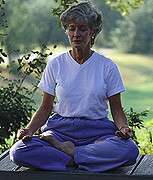What yoga can and can't do for you

(HealthDay)—Chances are that you've heard good things about yoga. It can relax you. It can get you fit—just look at the bodies of some celebrities who sing yoga's praises. And, more and more, yoga is purported to be able to cure numerous medical conditions.
But is yoga the panacea that so many believe it to be?
Yes and no, say the experts. Though yoga certainly can't cure all that ails you, it does offer significant benefits.
"Yoga is great for flexibility, for strength, and for posture and balance," said Dr. Rachel Rohde, a spokeswoman for the American Academy of Orthopaedic Surgeons and an orthopedic surgeon for the Beaumont Health System in Royal Oak, Mich. "Yoga can help with a lot of musculoskeletal issues and pain, but I wouldn't say it cures any orthopedic condition," she said.
Most practitioners would tell you that yoga isn't just about building muscle or strength.
"One of the issues in this country is that people think of yoga only as exercise and try to do the most physically hard poses possible," explained Dr. Ruby Roy, a chronic disease physician at LaRabida Children's Hospital in Chicago who's also a certified yoga instructor. "That may or may not help you, but it also could hurt you," she noted.
"The right yoga can help you," Roy said. "One of the primary purposes of a yoga practice is relaxation. Your heart rate and your blood pressure should be lower when you finish a class, and you should never be short of breath. Whatever kind of yoga relaxes you and doesn't feel like exercise is a good choice. What really matters is, are you in your body or are you going into a state of mindfulness? You want to be in the pose and aware of your breaths."
Roy said she uses many of the principles of yoga, especially the breathing aspects, to help children sleep, reduce anxiety, help with post-traumatic stress disorder, for asthma, autism and as support and pain management during procedures. "I may or may not call it yoga. I may say, 'Let's do some exercises to relax you for sleep,'" she said.
Bess Abrahams, a yoga therapist with the Integrative Medicine and Palliative Care Team at Children's Hospital at Montefiore in New York City, also uses yoga to help children who are in the hospital for cancer treatment and other serious conditions.
"Physically, yoga helps to strengthen the muscles that have been weakened from a lack of movement, and the stretching in yoga helps with muscular tightness," she said. "It also helps with discomfort from lying in bed or discomfort from a procedure."
Abrahams said that older children find that the meditative aspects of yoga can help reduce anxiety.
Results from medical research on yoga are mixed, according to the U.S. National Center for Complementary and Alternative Medicine, though the findings tend to be more positive than negative.
Yoga has been found to improve quality of life, reduce stress, anxiety, insomnia, depression and back pain. It has also been found to lower heart rate and blood pressure. And, perhaps not surprisingly, yoga has been shown to improve fitness, strength and flexibility, according to the alternative medicine center.
Research has not found yoga to be helpful for asthma. And, the research on arthritis has produced various results so, according to the center, the jury is still out on whether yoga may be helpful for arthritis.
Health experts note, however, that yoga should be considered a complementary therapy, not a replacement for standard therapy. For instance, if you have high blood pressure, yoga may help bring it down slightly, but you'll still need to take high blood pressure medication as prescribed by your doctor.
The good news is that yoga is generally very safe to try. Some people—including pregnant women and those with high blood pressure, glaucoma or sciatica—may need to modify poses to reduce the chance of injury.
It's important to start with a beginner class and "take baby steps in the beginning," Rohde said. "Don't feel like you're competing with the rest of the people in the class."
Roy agreed. "Part of this culture is no pain, no gain, but yoga should definitely be no pain," she said, suggesting that people new to yoga shouldn't even participate in a class initially. "Sit at the back of the room, and check out the class. Get to know the teacher to see if you feel comfortable there."
All three experts described yoga as a great tool for kids. "Yoga is safe and effective, and it's a wonderful way to bond with your child, and for your child to feel their own sense of self," said Abrahams. Both Roy and Rohde suggested that yoga could be a useful addition to physical education or health classes if taught properly.
So, given the health benefits of yoga, why don't more doctors prescribe it for their patients? Roy attributes that mostly to a lack of awareness of the potential benefits, something yoga aficionados hope to improve in September, designated National Yoga Awareness Month. And, the situation is already changing, she said.
"More doctors are becoming conscious of yoga and the mind-body connection as it relates to medical things," Roy said. "It's much more acceptable now to refer a patient for things like acupuncture, massage therapy and other complementary therapies."
More information: The U.S. National Center for Complementary and Alternative Medicine has more on yoga and your health.
Read this HealthDay story about a New York man who says yoga was a huge help during his recovery from a horrific injury.
Health News
Copyright © 2013

















